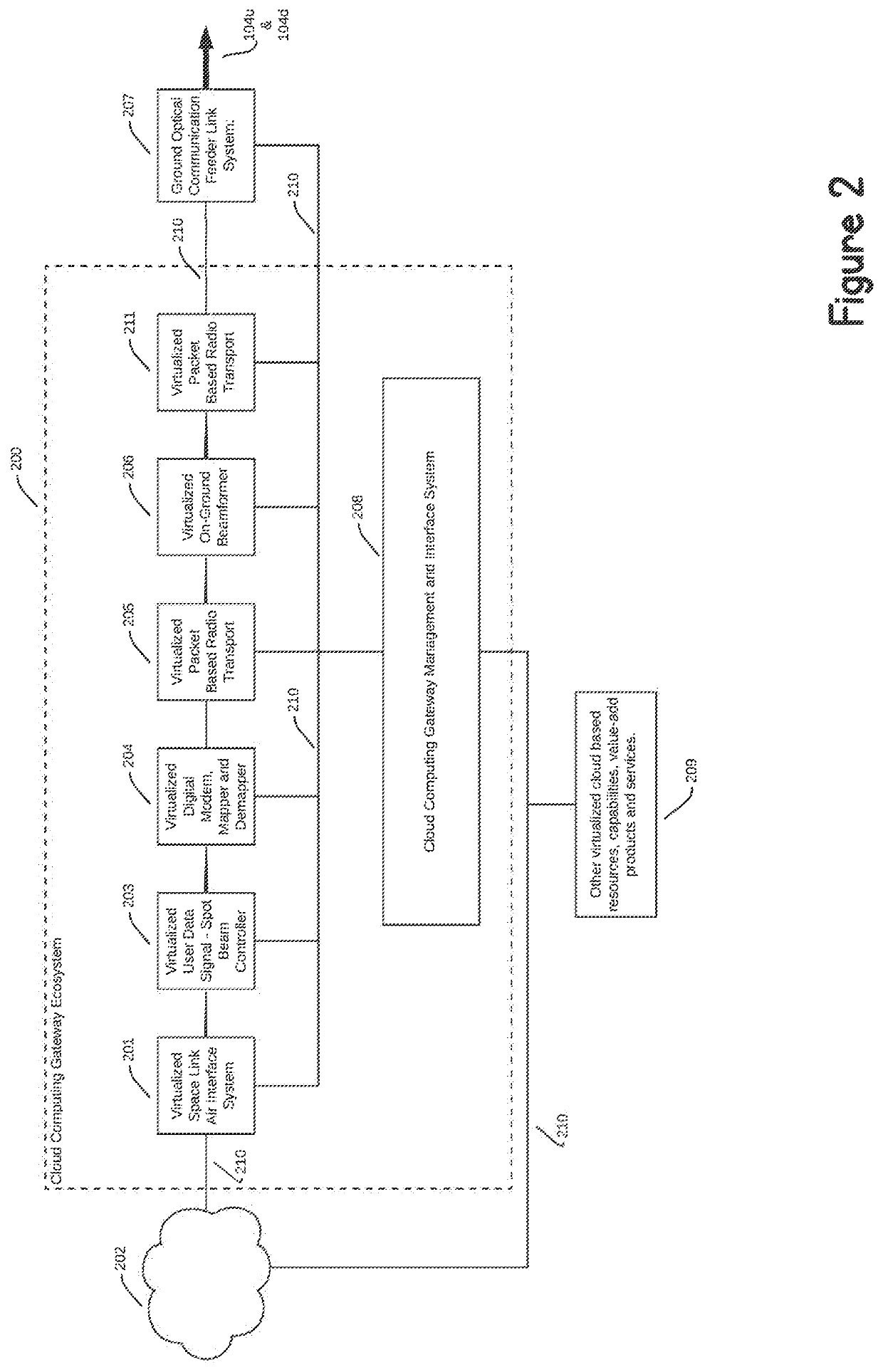Satellite communications architectures suffer from several problems with their implementations and critically from an inflexibility that leads to the inability to maximize the efficiency of the end-to-end satellite communication resource.
With current architectures it is extremely difficult to contract one-hundred percent (100%) of the available
radio frequency (RF) spectrum and / or power on a satellite with the customer base (especially with HTS, VHTS and UHTS), but crucially these systems prohibit achieving anywhere near high levels of satellite communications
resource utilization as multiple segments of all sizes can lie dormant for frequent and / or extensive periods while the end customers no longer use the assets.
This represent two fundamental issues, firstly the customer pays for an asset that they neither utilize completely or fully need, and secondly there are no effective solutions or technologies to significantly increase the overall satellite communications
resource utilization across a varied and varying customer base.
This situation further suffers when specific customers wish the ability to modify their contracted satellite communications resources in a dynamic, scheduled and / or ad-hoc sporadic manner, to no avail.
This problem is further exacerbated by the fact that satellite communications cover huge geographic areas, which means that its ‘last-
mile’ segment (satellite-subscriber terminal) can capture huge customer numbers, segments and / or applications, representing a huge, stymied demand.
Current technology suffers from the inability to flexibly manage and operate effectively and efficiently across a customer base representing unique segments requiring network bandwidth in different places, in different times, and / or in differing formats.
Such inflexibility is caused by current architectural issues in both the ground and
space segment components.
This leads to a highly fractalized or stove-piped infrastructure that is cumbersome, inflexible, and exceedingly difficult to operate, maintain,
upgrade, augment and / or reconfigure at short notice and / or in a dynamic manner.
This limits the investment in a satellite as the
hardware specification and capabilities are locked typically at least 2 year prior to launch and will be obsolete even prior to reaching
orbit, let alone 15-20 years later.
Such hardware dependent systems suffer from being fixed implementations and thus non-upgradeable after launch.
Further, the onboard satellite communication
beamforming systems do not support the complex issues of integration with the higher
layers (OSI Layer 2 and above) of multiple and / or dynamic satellite
baseband air interface operations of today let alone those of the future.
Although this open-system approach enables multi-application and multi-vendor markets that delivers innovation and competition, it suffers from the hard-coded ecosystems that
restrict the ability to holistically view, utilize, adapt, and maximize the return on available satellite communications resource such as RF spectrum, power, human resource, space and / or ground investments.
Additionally,
current technology does not allow implementations that deliver the ability to holistically view, utilize, adapt, coordinate, and maximize the return on available satellite communications resource across multiple satellites owned and operated by a single and / or multiple satellite operators.
However, it suffers from multiple limitations and problems, such as:expanding the rigid, inflexible, costly, and cumbersome hard-coded and stove-piped gateway environment and implementations;operation in the analog domain within the middle-
mile;requiring extensive and inflexible hard-coded GBBF hardware and gateway analog RF to optical conversion hardware;requiring the utilization of much
higher power demanding analog RF modulated optical
terminal system (gateway and satellite);requiring complex, extensive and highly lossy analog RF chains
on board the satellite;providing no effective
operational system to manage multiple optical gateways to provide
high availability.
Resiliency and redundancy suffer heavily when multiple hardware gateways must be exactly matched with hard-coded stove-piped configurations resulting in costly implementations that are impossible to modify in a real-time environment and entail complex coordination for any required systems upgrades;offers no solution to support beamforming integration with dynamic and / or multi satellite
baseband air interface operation; andoperation only with an extensive hardware dependent fractalized gateway infrastructure including hard-coded satellite
baseband air interface systems.
As such, they suffer from multiple limitations and problems, such as:onboard
processing cost,
obsolescence, and capability limitations;requiring extensive and multiple onboard modulation and
demodulation technologies to convert RF to / from baseband;no comprehensive integration of onboard satellite baseband air interface, or multiple and / or dynamic satellite baseband air interface support;lack of onboard
scalability and flexibility in matching satellite baseband air interface functions with beamforming functions;no holistic, comprehensive and / or
effective management of end-to-end satellite communications resource such as RF spectrum, power, space and / or ground investments; andinability to holistically view, utilize, adapt, coordinate, and maximize the return on available satellite communications resource either across the satellite or multiple satellites owned and operated by a single and / or multiple satellite operators.
 Login to View More
Login to View More  Login to View More
Login to View More 


